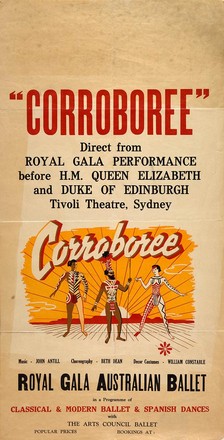
'Corroboree': Direct from Royal gala performance before HM Queen Elizabeth and Duke of Edinburgh, Tivoli Theatre, Sydney, 1954
POSTERS 1632 Transferred from the Dennis Wolanski Library of the Performing Arts, Sydney Opera House Trust, 1997

POSTERS 1632 Transferred from the Dennis Wolanski Library of the Performing Arts, Sydney Opera House Trust, 1997
During the first half of the 20th century, a greater understanding of Aboriginal culture was forged – sometimes controversially – by Daisy Bates (1859–1951), Ronald Berndt (1916–1990), Catherine Berndt (1918–1994), AP Elkin (1891–1971), CP Mountford (1890–1976) and TGH Strehlow (1871–1922). Their efforts were complemented after World War II by Victor Carell (1916–2001) and Beth Dean (1918–2012).
White Australians began to celebrate Aboriginal culture through writers such as Roland Robinson (1912–1992), who set down Aboriginal myths and legends in a number of books from the 1940s onwards. Robinson also performed with the Kirsova ballet company and became the Sydney Morning Herald dance critic. Margaret Preston (1875–1963), who proposed a national art based on Aboriginal art, influenced Robin Lovejoy (1923–1985), one of the designers for the ballet.
John Antill (1904–1986) was inspired to compose an orchestral suite by a real corroboree he witnessed at La Perouse in 1912. His suite was first performed in 1946 by the Sydney Symphony under the baton of Sir Eugene Goossens (1893–1962). Antill fired up the imagination of his friend, the stage designer William Constable (1906–1989), who began creating decor and costumes. Goossens, a catalyst for the advancement of the arts in New South Wales after World War II, championed Antill’s work in Australia and England.
Dorothy Helmrich (1889–1984), founder of the Arts Council of Australia, became a driving force in presenting the work as a ballet. The 1950 premiere of the ballet, choreographed by Rex Reid (1921– 2000), performed by the National Theatre Ballet Company, and with costume designs by Robin Lovejoy, was hailed as a "coming-of-age" in Australian cultural life.
The 1954 modernist ballet Corroboree was inspired by the corroboree of Australian Aborigines and attempted to interpret the Dreamtime from a white perspective through dance, music and costume. Even though the décor and costumes had rave reviews in the press, William Constable’s design input into the 1954 production of Corroboree was overlooked for decades.